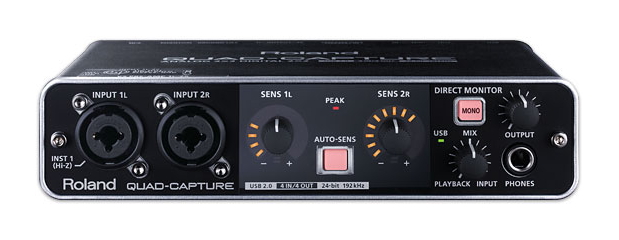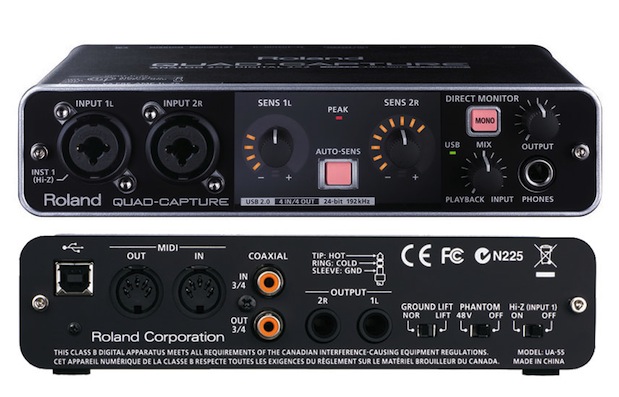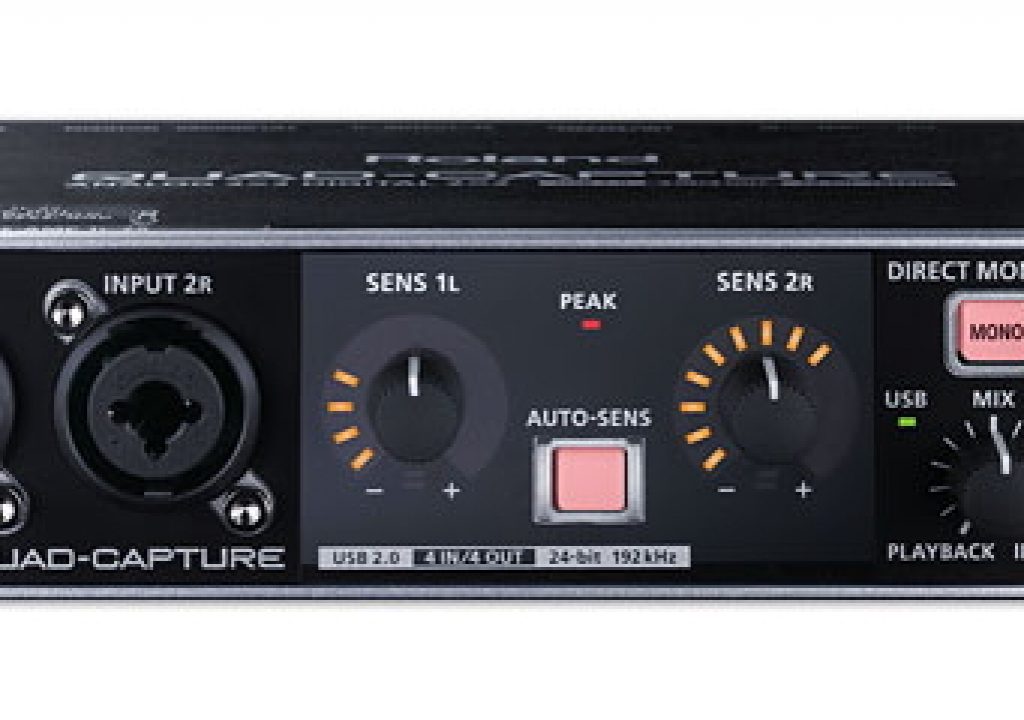
ProVideo Coalition readers who are into audio gadgets probably read my recent full review about the OCTA-CAPTURE from Roland. This article is about the OCTA-CAPTURE’s little sister, the QUAD-CAPTURE, and covers the differences between the two units, as well as its relative preamp and ADC (analog>digital conversion) quality compared with similar devices. Both of the two sisters connect to a computer via USB. One of the first things you’ll notice is that the QUAD-CAPTURE’s name insinuates more microphone inputs than it really has.
How many inputs?
Unlike the OCTA-CAPTURE (see my full review here), which has ten audio inputs of which eight can be balanced microphone sources via XLR, the QUAD-CAPTURE (US$349 list/US$269 street) has only two balanced microphone inputs via XLR/TRS (tip/ring/sleeve) connections. The “quad” name -at least to me- implied that it would have four such inputs. The QUAD-CAPTURE does have two other inputs, but they are not for microphones; they are not analog, but digital (coaxial). The QUAD-CAPTURE also has MIDI i/o.

To be fair, when looking at the QUAD-CAPTURE from the top, just under the name QUAD-CAPTURE, it says “ANALOG 2×2 DIGITAL 2×2”.
QUAD-CAPTURE feature set
- Two combo XLR/TRS inputs with premium mic preamps (VS Preamps, the same ones used in the OCTA-CAPTURE), two TRS outputs, coaxial I/O, headphone out, and MIDI I/O
- Digital compressor and gate, software adjustable to treat microphone inputs 1 & 2 as stereo (where it adjusts the compressor of both channels based upon input 1) or dual mono (where each of those inputs is handled by its own independent compressor)
- Graphical control panel software provides control of the preamps
- Switches for phantom power (global), ground lift (global), and Hi-Z switches (only for microphone input 1)
- One-click AUTO-SENS function automatically sets optimal input levels for the preamps (I didn’t use them in my tests, but could be beneficial in certain situations.)
- Extreme low-latency VS Streaming driver
- Low-noise, wide-range power supply
- Compact with durable aluminum body and Direct Box functionality
- Bundled with Cakewalk SONAR X1 LE (I did not install or test.)
Unlike the OCTA-CAPTURE which requires AC power, the smaller QUAD-CAPTURE runs on USB bus power. Like the OCTA-CAPTURE, the QUAD CAPTURE also requires the installation of drivers and an application even on Mac.
Preamp/ADC quality, and how I made my tests
For this review and several similar ones I am doing on other devices, I decided to use TecnoTur´s revered Heil PR-40 large diaphragm dynamic microphone as the reference microphone in order to evaluate the preamp and ADC (audio>digital converter) in each device. [Note: This section of the article will be repetitive for those who already read my review on the OCTA-CAPTURE.] Since the PR-40 microphone is dynamic, I did not use any phantom power. To be fair with all of the devices, I left filters, compressors and limiters off during the tests. With all of them, I recorded the best audio level possible, although with some, there was not quite enough amplification even at maximum gain. Although generally when I record audio podcasts, audio spots, or audiobooks, I record at 44.1KHz, for any audio to be used with video, I do it at 48KHz, which is the standard for digital-audio-for-digital-video. That’s why I recorded all of the samples made for this and the other related reviews at 48KHz. Following you will find downloadable raw 48KHz WAV files to compare the audible quality of each. When I say ?raw?, I mean that no post-processing has happened on the original 48KHz, other than to export it as a mono 48KHz WAV file. Depending upon your browser, you can right-click and Download linked file as… or Save link as…:
- Edirol/Roland FA-66 (now discontinued). This is the audio interface we have been using for quite some time in the TecnoTur studio, and is the only one of this group that connects via IEEE-1394 (FireWire). The FA-66 is quite comfortable to use with a Mac, since it works natively, without installing any other driver. The FA-66 uses bus power, so it requires no other power source. Download FA-66 audio test file here.
- Edirol/Roland OCTA-CAPTURE. Although recorded with the OCTA-CAPTURE, it has the same exact preamp and ADC as the QUAD-CAPTURE. Download OCTA-CAPTURE audio test file here.
- Sony PCM-M10 standalone recorder with Heil PR-40 microphone connected directly (without a balancing transformer, floating the ground). Download PCM-M10 without balancing transformer audio test file here.
- Sony PCM-M10 standalone recorder with Heil PR-40 microphone connected via a Hosa balancing transformer. Download PCM-M10 with the Hosa balancing transformer audio test file here.
- Sound Devices USBPre2. Like the FA-66, this one also works natively with Mac, without having to install any other driver. Download USBPre2 audio test file here.
Feel free to download each recording and form your own opinion. Although the FA-66 has always sounded good to me and many other people (especially after the post-processing I use), all of the other ones I tested sound even better than it does. To be more specific, to my ear the OCTA-CAPTURE and PCM-M10 both sounded extremely good, while the USBPre2 sounded superb. Standby for upcoming articles about the PCM-M10, and the USBPre2. And if you haven’t yet, consider reading my review on the OCTA-CAPTURE, especially since that is more complete than this one, which mainly covers the differences.
Conclusions
As stated in the OCTA-CAPTURE review, up until now, I have been using the discontinued Edirol/Roland interface, the FA-66, which connects to the computer via IEEE-1394 (FireWire). I have been evaluating other interfaces which connect via USB 2.0 instead of IEEE-1394, since it´s likely that my next computer will no longer have any type of IEEE-1394. I would continue to recommend the OCTA-CAPTURE to anyone who needs to record more than two microphones simultaneously and would like to have the flexibility of having each one on and individual track. I would recommend the QUAD-CAPTURE for someone who is covered by the fewer inputs it offers, and wants/needs the compression/gate feature, at a very attractive street price of about US$269. Personally, I’d really love to see an in-between product between the QUAD-CAPTURE and the OCTA-CAPTURE, with four balanced XLR microphone inputs (not two and not eight). In the meantime, those of us who like the compressor/gate features and the price range will have to choose among these two!
Upcoming articles, reviews, and books
Stand by for upcoming articles, reviews, and books. Sign up to my free mailing list by clicking here.
Si deseas suscribirte a mi lista en castellano, visita aquí. Si prefieres, puedes suscribirte a ambas listas (castellano e inglés).
My latest book (paperback + ebook)
My most recent book is available in two languages, and in paperback as well as an ebook. The ebook format is Kindle, but even if you don’t have a Kindle device, you can read Kindle books on many other devices using a free Kindle app. That includes iPad, Android tablets, Mac computers, and Windows computers. Although generally speaking, Kindle books are readable on smartphones like Androids and iPhones, I don’t recommend it for this particular book since it contains both color photos and color comparison charts. The ebook is also DRM-free.
In English:
In English, it is currently available in the following Amazon stores, depending upon your region:
- Amazon.com, for the US and other countries in the Americas that don’t currently have their own Amazon store, or anywhere if you simply prefer it
- Amazon.br for Brazil
- Amazon.ca for Canada
- Amazon.de for Germany
- Amazon.es for Spain pero a lo mejor lo preferirás en castellano, a continuación)
- Amazon.fr for France
- Amazon.in for India
- Amazon.it for Italy
- Amazon.co.jp for Japan
- Amazon.com.mx for México
- Amazon.co.uk for the United Kingdom
Or in your favorite bookstore by requesting ISBN–10: 1456310232 or ISBN–13: 978–1456310233.
En castellano:
En castellano, está disponible actualmente en las siguientes tiendas Amazon, según tu región:
- Amazon.com para EE.UU. y todas las Américas donde no existe ninguna tienda particular… o en cualquier parte si simplemente lo prefieres
- Amazon.com.br para Brasil
- Amazon.co.jp para Japón
- Amazon.de para Alemania
- Amazon.es para España
- Amazon.fr (Francia)
- Amazon.in para India
- Amazon.it para Italia
- Amazon.com.mx para México
- Amazon.co.uk para el Reino Unido
o en tu librería preferida al solicitar el ISBN–10: 1492783390 ó el ISBN–13: 978–1492783398.
Allan Tépper’s other books, consulting, articles, seminars & audio programs
Contact Allan Tépper for consulting, or find a full listing of his books, articles and upcoming seminars and webinars at AllanTepper.com. Listen to his TecnoTur program, which is now available both in Castilian (aka “Spanish”) and in English, free of charge. Search for TecnoTur in iTunes or visit TecnoTur.us for more information.
FTC disclosure
No manufacturer is specifically paying Allan Tépper or TecnoTur LLC to write this article or the mentioned books. Some of the other manufacturers listed above have contracted Tépper and/or TecnoTur LLC to carry out consulting and/or translations/localizations/transcreations. Many of the manufacturers listed above have sent Allan Tépper review units. So far, none of the manufacturers listed above is/are sponsors of the TecnoTur programs, although they are welcome to do so, and some are, may be (or may have been) sponsors of ProVideo Coalition magazine. Some links to third parties listed in this article and/or on this web page may indirectly benefit TecnoTur LLC via affiliate programs.
Copyright and use of this article
The articles contained in the TecnoTur channel in ProVideo Coalition magazine are copyright Allan Tépper/TecnoTur LLC, except where otherwise attributed. Unauthorized use is prohibited without prior approval, except for short quotes which link back to this page, which are encouraged!


